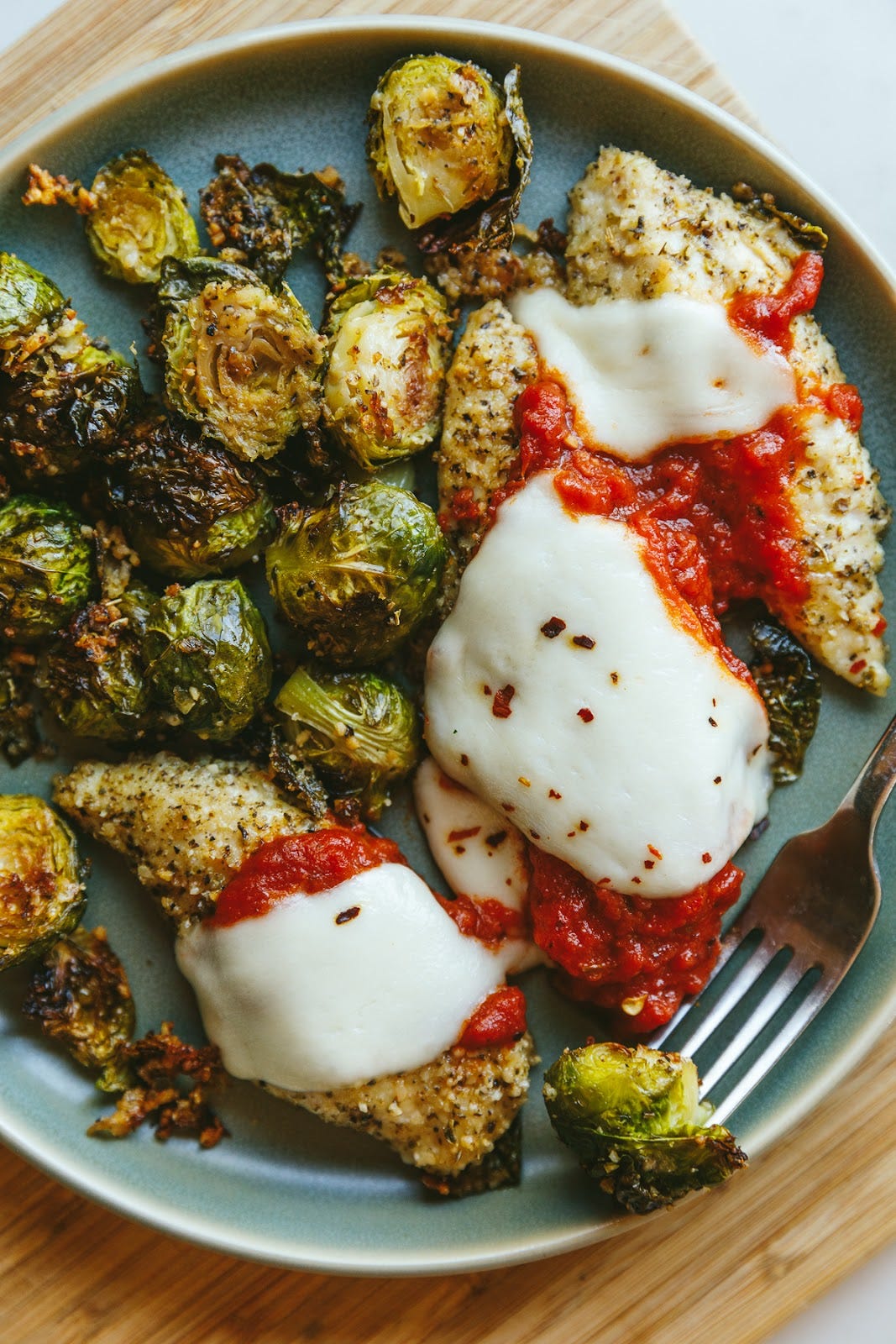welcome, Abby Cooper!
Hello, it’s so great to be back as a guest author here with Beth’s wonderful Substack community! (Thank you, Beth!)
I’m a recipe developer, a food blogger, and a mom of three lively kiddos (ages 10, 8, and 1). I live in Arizona, where the temps are really starting to heat up as we head into another summer in the desert.
Today, I’m going to share…
How my husband’s stage-four brain cancer diagnosis drastically changed how my family views our health, and how we view food.
5 practical, family-friendly tips for healthy cooking
A favorite sheet pan recipe
Thanks for following along with me!
My philosophy on food and how it plays a role in our overall wellness is very similar to Beth’s, and it shapes the way that I cook and feed my own family. I create low-carb and ketogenic-friendly recipes on my blog Stem and Spoon, and I also write a weekly Substack newsletter called At the Table, where I share a grain-free, low-carb/low-glycemic dinner recipes every week that prioritizes bold flavors and 30-minute meals.
Our Story
I haven’t always eaten this way, and I haven’t always fed my children this way either. In April, my family celebrated a major milestone for my husband Ian: eight years (!!!) since his stage-four brain cancer diagnosis that drastically altered all of our life plans and our “normal.” What I didn’t know is that his diagnosis would lead to a complete transformation in how we view our health, and consequently, how we view food.
Up until then, as a young, two-working-parent family with a baby and a toddler, we were following a very standard American diet, which leaned on convenience, the classic food pyramid, and mainstream ideas about food and nutrition. I had never heard about eating for metabolic health until my husband and I sat in the office of an oncology dietician who explained the different metabolic processes that a specific diet could have in improving the grim prognosis he had been given.
Many of our diet changes happened immediately (at least for Ian), but I still found myself often reverting back to old habits in this really difficult and stressful season of life, especially when it came to feeding our young kiddos who were old enough by that point to make it very clear which foods they liked and didn’t like. (Spoiler: they didn’t like our new approach to eating.)
Now that my older two are almost 9 and 11, I can see how small, intentional changes over time, plus repeated exposure to various flavors and ingredients, has helped them become adventurous eaters who appreciate real foods and are more willing to try new dishes.
Small Changes Over Time
I want to share this because I know that feeding little ones– or even making healthy changes in how we feed ourselves– can be frustrating when we feel like we aren’t making any noticeable headway. Kids can be picky. Cravings can be hard to manage. Stressful, busy schedules and commitments can make meal preparation an extra challenge.
There’s a lot stacked up against us. But a commonly overlooked truth is that the best change is often gradual. Creating healthy habits for ourselves and the ones we love can and will happen gradually if we continue to try–and it doesn’t have to be all or nothing.
I love the idea of “one percent better over time,” and I sometimes use this concept to encourage myself when it comes to nutrition. It is not about following fad diets, relying on quick fixes or “viral” wellness trends. It’s about choosing real foods that support our nutrient needs, blood sugar balance, and longevity… for the long run. This is the philosophy I teach my kids and one that I hope they adopt as adults.
5 practical tips for healthy cooking (this is what I prioritize)
Cooking this way can also be very simple, and it’s my mission to prove just that! In this season of life I’m in, it’s a balance of parenting, work, school, extra-curriculars, and family time. It’s a juggle and I, like you, I’m sure, could definitely use more hours in the day!
So, as a working mom of three who cares deeply about feeding my family real foods that are nutrient dense and support their health, here are five practical tips that I would share with anyone looking to do the same.
Make the majority of your meals. I believe this right here is such a game changer. If you’re not already cooking for yourself the majority of the time, this shift alone has the potential to improve your health. You’ll gain more control over what you’re consuming, you’ll have the ability to eat a wider array of nutrient-dense foods, and you will overall reduce so many added sugars, processed ingredients, preservatives, and unhealthy oils. The cost savings are an added bonus (and usually significant!). This is my top priority, and even when I don’t know what to cook or don’t feel like cooking, I often push through anyway, and I’m always so happy that I did.
Think ahead and meal prep when possible. I don’t have a set “meal prep” day, where I spend hours preparing food in advance. But I do often think ahead and mini meal prep where I can. This can look like scaling up on a simple, healthy recipe that I know will keep well. Or spending five minutes to make a Greek yogurt chia pudding for the next morning. If I have the grill or the oven going, I’ll prepare extra roasted/grilled veggies or throw on some chicken to use for a lunch power bowl, salad, or dinner the next day.
Be creative but don’t overcomplicate it. You don’t need to put in a whole lot of effort to make nutritious meals exciting. Sometimes, all you need are a handful of spices, a protein, and a veggie to create a dinner the entire family will love. But being creative in the kitchen doesn’t necessarily mean cooking gourmet; for me, it also means variety.
I aim to use (or at least try) a variety of real foods, and continue to introduce new foods to my kiddos (and myself/my husband!) versus rotating between their known favorites. Something that has really helped our family eat more vegetables is a Community Supported Agriculture (CSA) box from a local farm. Every week, my box contains locally-grown produce, often 1-2 items I probably wouldn’t have picked up from the grocery store. This is a fun way to try new vegetables, change things up/challenge your creativity, and expose little eaters to a wide assortment of real foods (and where they come from!). If you are able to sign up for a CSA program, you’ll also enjoy seasonal produce that is picked fresh and at its nutritional peak.
If you can’t access a CSA program, I recommend looking up what’s in season every month. A lot of times you’ll notice these items are on sale at your grocery store. I also like to be inspired by seeing how others use ingredients. Restaurant menus, social media, or the cookbook section at Barnes and Noble or our local library is sure to leave me with fresh ideas. Sometimes, a little recipe inspiration is the push I need to try out a new food.
4. “Family food” is all you need. If you’re a parent to little ones, most of the time, they can eat what we eat. Make family food– one meal that everyone can enjoy and that you can easily customize or “deconstruct” for the littlest eaters. There’s no need to make a separate meal (no, kids don’t need “kid food” and this is something I wish I could go back and tell myself 10 years ago!). There are so many benefits to everyone eating the same thing: kids become more accustomed to nutritious real foods, they become more adventurous eaters, and it’s more budget- and time-friendly, too.
5. Give yourself grace. This one is especially important for me to mention because I think this is where we get hung up sometimes, especially if a new way of eating stems from a need to manage a health condition. Right after my husband’s diagnosis, I remember being incredibly overwhelmed about every food choice, poring over every nutritional label, studying the “rules” for what was ketogenic friendly. It was stressful and unhealthy during a time when I needed just the opposite.
Does every meal follow these tips? Absolutely not. There are always exceptions to be made: sick days, busy days, off days, celebratory days, etc. Do what you can, try not to let your food choices stress you out or control your thoughts, and remember that you have every opportunity to try again with the next meal.
the recipe: Sheet pan chicken Parmesan tenders + Brussels sprouts
Sheet pan dinners are always welcome, but I’m especially grateful for them lately! This one combines roasted-and-crispy Brussels sprouts with chicken tenderloins seasoned in a spice/Parmesan mixture, then topped with marinara and melt-y mozzarella cheese.
When I shared it a few weeks ago in my newsletter, I noted that it’s a cross between three of my favorite things: comforting Italian food, crispy roasted Brussels sprouts, and chicken tenders. The epitome of family food, if you ask me.
Yield: ~4 servings
Prep time: ~30 minutes
Ingredients
1 cup grated Parmesan cheese (you will need ¾ cup once it’s finely chopped)
1 teaspoon fine sea salt
¾ teaspoon ground black pepper
1 teaspoon garlic powder
½ teaspoon onion powder
1-½ tablespoons Italian seasoning
1 to 1-¼ pounds chicken tenderloins (approx. 10 pieces)
1 pound Brussels sprouts, ends trimmed and halved
2-½ tablespoons extra-virgin olive oil
¾ cup marinara sauce
3-4 ounces fresh mozzarella cheese, torn
Red pepper flakes or fresh basil (optional)
Method
Preheat the oven to 400°F. Add the grated Parmesan cheese to a food processor and pulse several times to turn it into Parmesan crumbs. If you prefer, you can also do this by finely-chopping it on a cutting board (but the food processor is quicker). Add the salt pepper, garlic powder, onion powder, and Italian seasoning to the cheese and pulse to mix. (Or, add the cheese and spices to a bowl and whisk to combine.)
Pat dry the chicken tenders with a paper towel and place them on one side of a large sheet pan. On the other side, add the halved Brussels sprouts. Drizzle 1 tablespoon of the olive oil over the chicken and use your hands to spread it around and evenly coat the tenderloins. Drizzle the remaining 1-½ tablespoons of olive oil on the Brussels sprouts, then toss to coat. Sprinkle the Parmesan cheese/spice mixture over the chicken and Brussels sprouts and toss, but keep the veggies and the chicken each on their own side of the pan. You can press the cheese mixture firmly onto all sides of the chicken and Brussels– it’s okay if there is loose Parmesan on the pan (this will give you deliciously yummy crispy bits).
Push the chicken pieces close together on one side of the pan, and arrange the Brussels sprouts cut side down on the other side, being careful not to overcrowd them (you can crowd the chicken pieces to make more room for the Brussels sprouts).
Transfer the sheet pan to the oven and cook for 16-18 minutes. Remove and use a metal spatula to lift the Brussels sprouts and toss them (the cut sides should be a nice golden brown). Spoon the marinara over the chicken pieces and top them with torn fresh mozzarella. Return the pan to the oven and cook for another 2-4 minutes or until the mozzarella has melted and the chicken tenders are a light golden brown.
Remove from the oven and let it rest for 3-5 minutes, then serve with red pepper flakes or basil, if desired.
Recipe notes
You can crowd the chicken tenderloins together, but try to give the Brussels sprouts a little breathing room on the pan. If they are too close, they will steam each other instead of roasting. I’ve found that exactly one pound of Brussels sprouts can fit on the pan with the chicken so if you have a little more than that, you can transfer them to a separate sheet pan to roast.
The chicken will release some water as it cooks, and there will be a little more water released from the marinara and mozzarella. It should all stay on the chicken side of the pan. Make sure to pat dry your chicken tenderloins before you begin, to remove as much excess water as possible.
I like Raos’ marinara sauce for its ingredients and taste but any marinara works.
Substitutions
Chicken: Tenderloins are a great cut for this recipe because they cook quickly, they don’t release too much excess water, and they won’t dry out as easily as other lean cuts. You can substitute them for thin-sliced chicken breast or small boneless/skinless chicken thighs if preferred.
Brussels sprouts: These roast beautifully with the Parmesan cheese and require the same amount of time to cook as the chicken. However, you can substitute them with diced sweet potatoes or small cauliflower/broccoli florets. If you’d like to use asparagus or green beans instead, I recommend cooking the chicken for 10 minutes first, then adding the veggies to the pan and letting them cook for the next 10 minutes with the chicken.
Parmesan cheese/dairy-free version: Since this is a chicken Parmesan recipe, the Parmesan plays a big role in the textures and flavors of the meal. I haven’t tried any plant-based Parmesan cheeses but I imagine you could substitute a vegan Parmesan and omit the mozzarella to make this dairy-free. You could also toss the chicken and Brussels sprouts in the spices on their own – I’d add about ½ teaspoon of extra salt.
If you are looking for dinner inspiration with a focus on low-carb, low-glycemic, and grain-free eating, I hope you consider subscribing to my newsletter, At the Table! You’ll get immediate access to all of the recipes here, along with an all-new weekly dinner recipe, a bonus dessert recipe, and a week-long meal plan that I send out once a month.
I also have over 350 recipes on my blog! Here are some reader favorites:
Grain-free vanilla almond butter granola (my copycat version of Simply Elizabeth’s)
Thank you for reading, and thank you for being here!
—Abby
download the recipe
Nutrition
Nutritional information is calculated by MyFitnessPal, based on an estimate of 4 servings.
Calories: 427
Total fat: 22 g
Total carbohydrate: 15 g
Dietary fiber: 4 g
Total sugar: 5 g
Protein: 46 g
Total net carbs: 11 g

















Thank you, Beth! ❤️ You have a lovely Substack community!
Love this Abbie! 💜